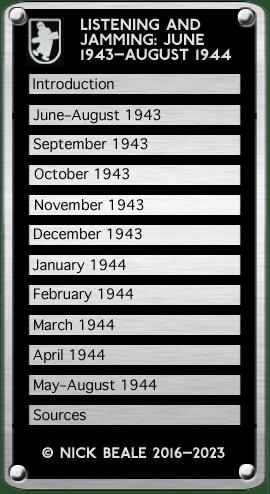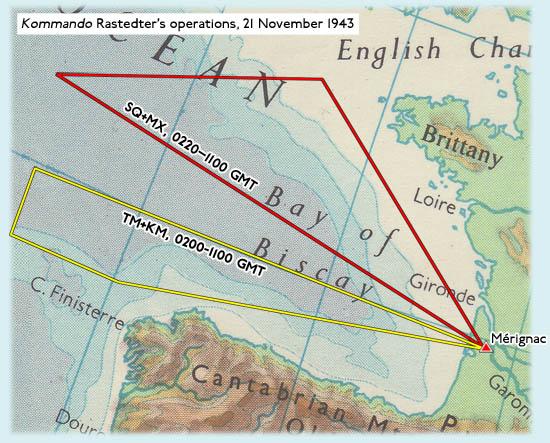|
More information than before came through about operations proposed for the 21st, when a pair of He 111 were to take off at 0100 and 0120: TM+KM (He 111 H-6, W.Nr. 7580?) was to fly the route Mérignac – 24W 3671 – 24W 3411 – 14W 0411 – Mérignac; for SQ+MX (He 111 H-16, W.Nr. 161260) the course assigned was Mérignac – 14W 7961 – 24W 3711 – Mérignac. At 0930 that day Ju 188 F-1 W.Nr. 280010 (NK+ZG) took off from Mérignac and crossed the coast 15 minutes later near Lège-Cap-Ferret. It was to fly to a point about 800 km WMW of base, returning over the same stretch of coast at 1530.
Two days later, unsuccessful calls were made to aircraft “L” under a radio protocol used by both the Sonderkommando and the He 177s newly arrived for Atlantic operations. Another individual aircraft is identifiable from the mission announced for the afternoon of 26 November, Ju 188 F-1, W.Nr. 280010 (NK+ZG). A warning was issued to destroyers Z23, Z24 and Z27 that this machine was due to fly again from 0936 on the 29th on the route Mérignac – 24 West 1711 – 24 West 1671 – Mérignac, requesting a weather report from its base while heading for home at 1550; on the 30th it was the turn of SQ+MX once more, taking off at 0130 to fly Mérignac – 24 West 3724 – 24 West 3521 – Mérignac, a circuit expected to take around 7½ hours.
Four test flights which may have involved the Kommando were notified to naval authorities on the 30th: He 111, take-off from Bordeaux at 0900 for an exercise flight “in the area 14 West North SS5 and QS 3. He 111, take-off in “14 West North RT” at 1230, cross coast “in 14 West KR” between 1330 and 1400, fly in again between 1415 and 1545. Ju 188 and He 111, take-off from Bordeaux at 1330, cross coast in and out at Mimizan-Plage, land c. 1445. Ju 88 and He 111, take-off at 1545, cross coast c. 10 km south of Mimizan-Plage, along coast to Arcachon, return to outward crossing point, land c. 1630. As the month ended, the Kriegsmarine issued a report on “Defence Situation in Biscay November 1943” which included this comment: Aircraft attacking tactics continue apparently to be founded on an unknown method of location followed by attack with searchlight. ‘Naxos’ location has been reported by only one of the boats attacked … Attacks in inner Biscay by night have become more frequent again. Operation of own night fighters has just begun. No result is yet to hand. The electronic battle was not entirely one-sided for during November W.L. Horwood of Britain’s Royal Aircraft Establishment (RAE), Farnborough compiled a report about enemy jamming of ASV Mk. II and how operators might best deal with it. The paper does not discuss the sources of these German countermeasures but they are likely to have been ship- or shore-based since no airborne set is known to have been in service at this juncture. continued on next page …
|
|||


